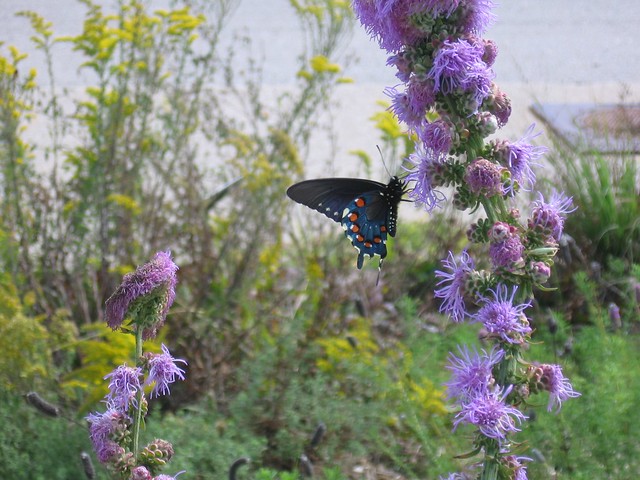 |
| Pipevine Swallowtail on Liatris, Yvonne Homeyer © |
I saw my first Pipevine Swallowtail of the year here in Missouri on June 18. Her black wings were just a blurs as she fluttered along my pipevine. Pipevine is the only plant that Pipevine Swallowtails use as a host. The only other member of its genus in the US is the Polydamas Swallowtail, which also uses pipevines. It’s interesting that the world’s largest butterfly, the Queen Alexandra Birdwing of eastern Papua New Guinea also lays her eggs on a pipevine relative.
Linnaeus, who gave our Pipevine Swallowtail its scientific name, Battus philenor, could have seen a relative of the butterfly in Europe. At first I thought that Battus might refer to its flight pattern, which actually is kind of bat-like. However, the Latin word for bat is “vespertilio,” so that can’t be right. “Battus” or “Battuti” refers to a 14th Century group of folks who paraded through town whipping themselves. Possibly the color of the butterfly is related to the costumes of the Battuti? No, reportedly, the Battuti did not wear shirts at all. Hmm. Could the rapid wing beat of Pipevine Swallowtail suggest the French “battus,” that is, “beaten”?
My own theory is that Linnaeus named the genus after Battus of Cyrene, who was worshipped after his death as Aristaeus. Aristaeus is described as a one of the Greek’s minor gods, who taught humans to raise bees and make cheese. “Aristaeus” also means “the best”—well deserved if he’s responsible for cheese—and a word that seems suspiciously like Aristolochia, the genus name of the plant that Pipevine larvae eat. Still with me? Thus, it could be that Battus is the synonym for the genus name, Aristolochia, which the insect requires. More about that plant in later posts.
Philenor, the specific name, comes from the Greek for “loving one’s husband.” Linnaeus didn’t explain that one either.
A warm thank you to Yvonne Homeyer who sent me a photo above from our fieldtrip with St. Louis Chapter of North American Butterfly Association. It shows a Pipevine Swallowtail on Liatris. What a sight Jeff Pippin saw at this “puddle party” of Pipevines! Apparently, these guys are sipping minerals from the damp sand—sort of like meeting at Starkbucks.
 |
| Puddle Party of Pipevine Swallowtails, Buncombe Co., NC by Jeff Pippin |
I love Pipevines too! We saw hundreds and hundreds of them puddling at Shawnee State Park (the one in Ohio), then they all rose up in a whirlwind. It was a spectacular sight. I doubt I'll ever see it again (but I can hope)! I loved reading all the information you supplied!
ReplyDeletep.s. your title made me chuckle!
ReplyDeleteI'd love to see a whirlwind of Pipevines. Thanks for your comments Kelly!
ReplyDelete